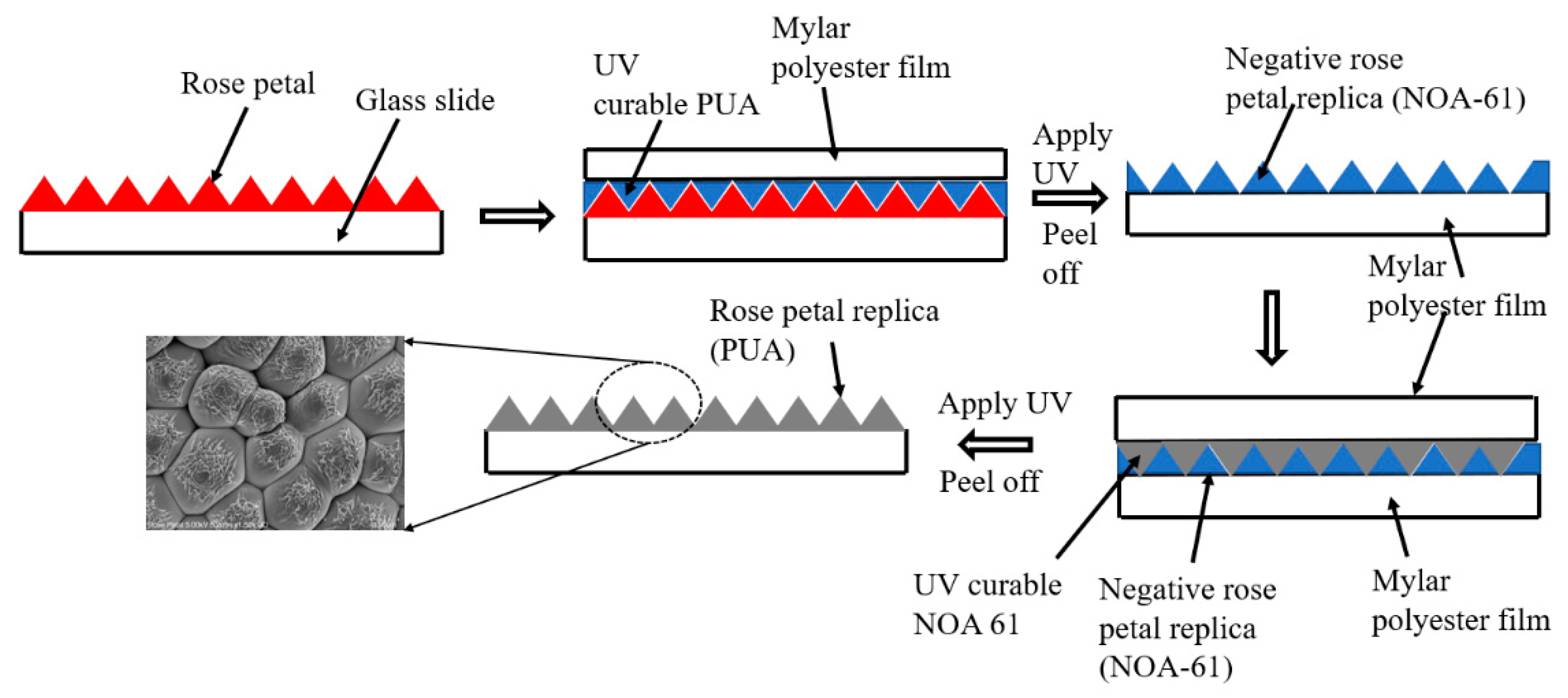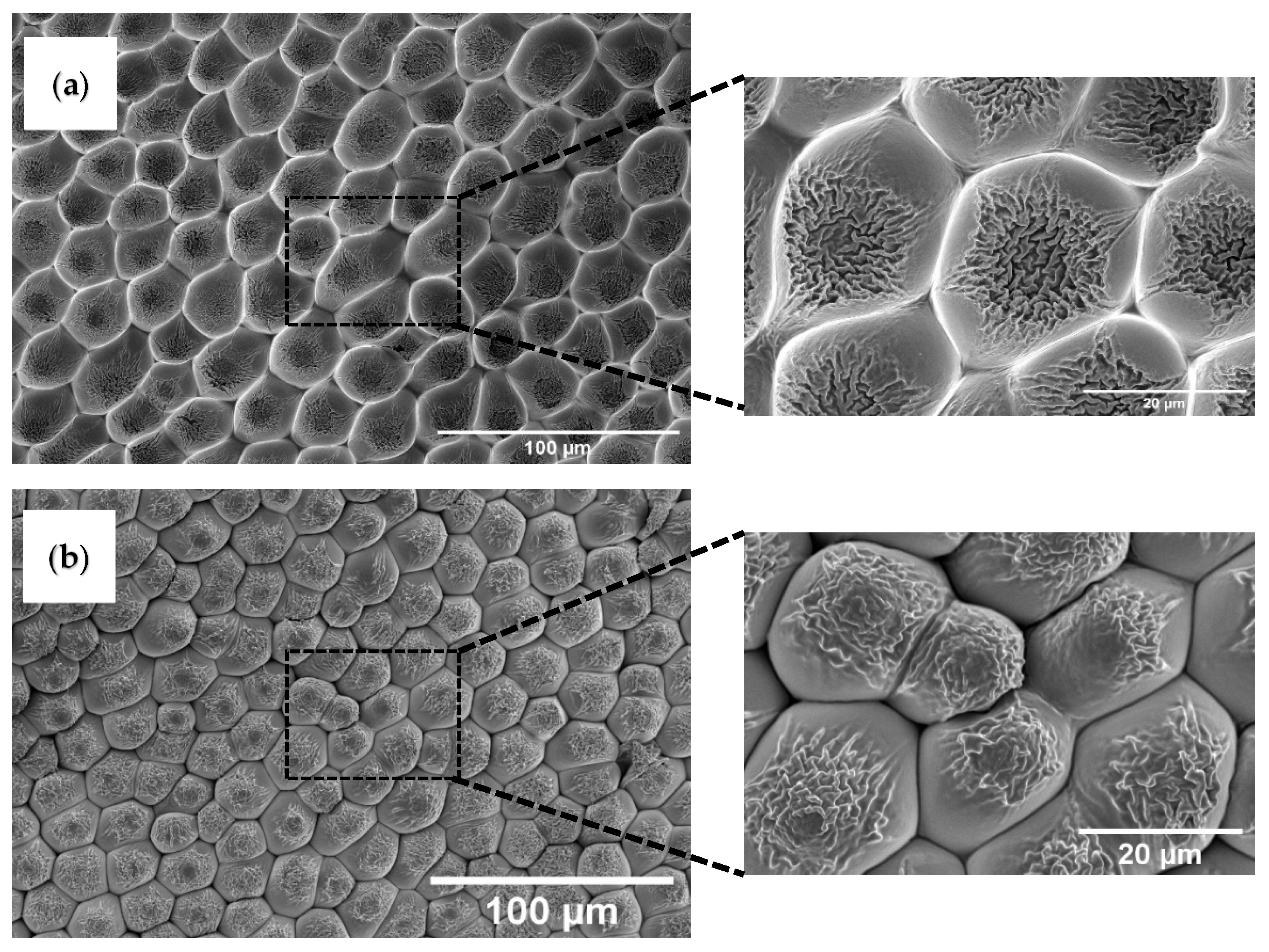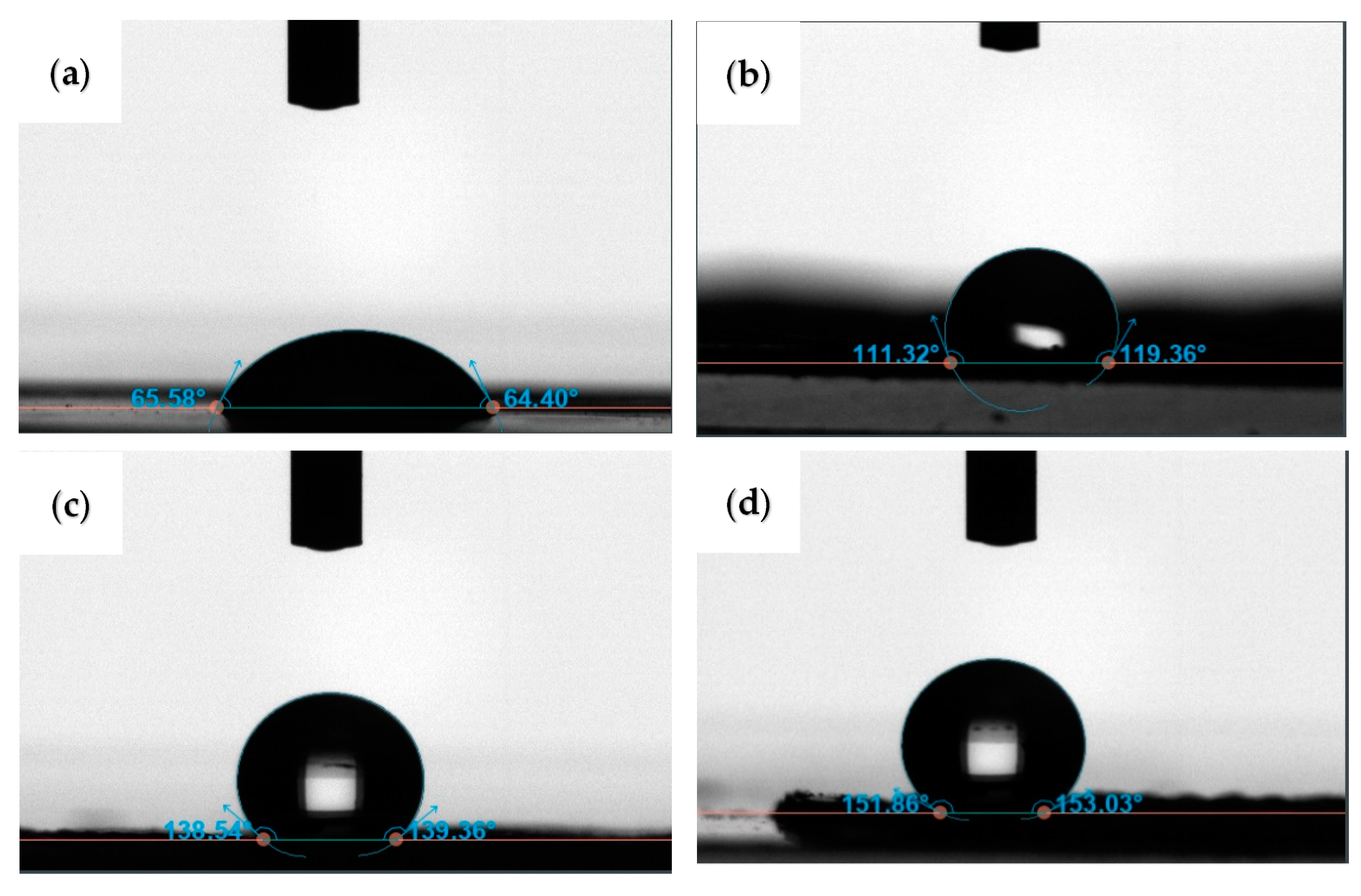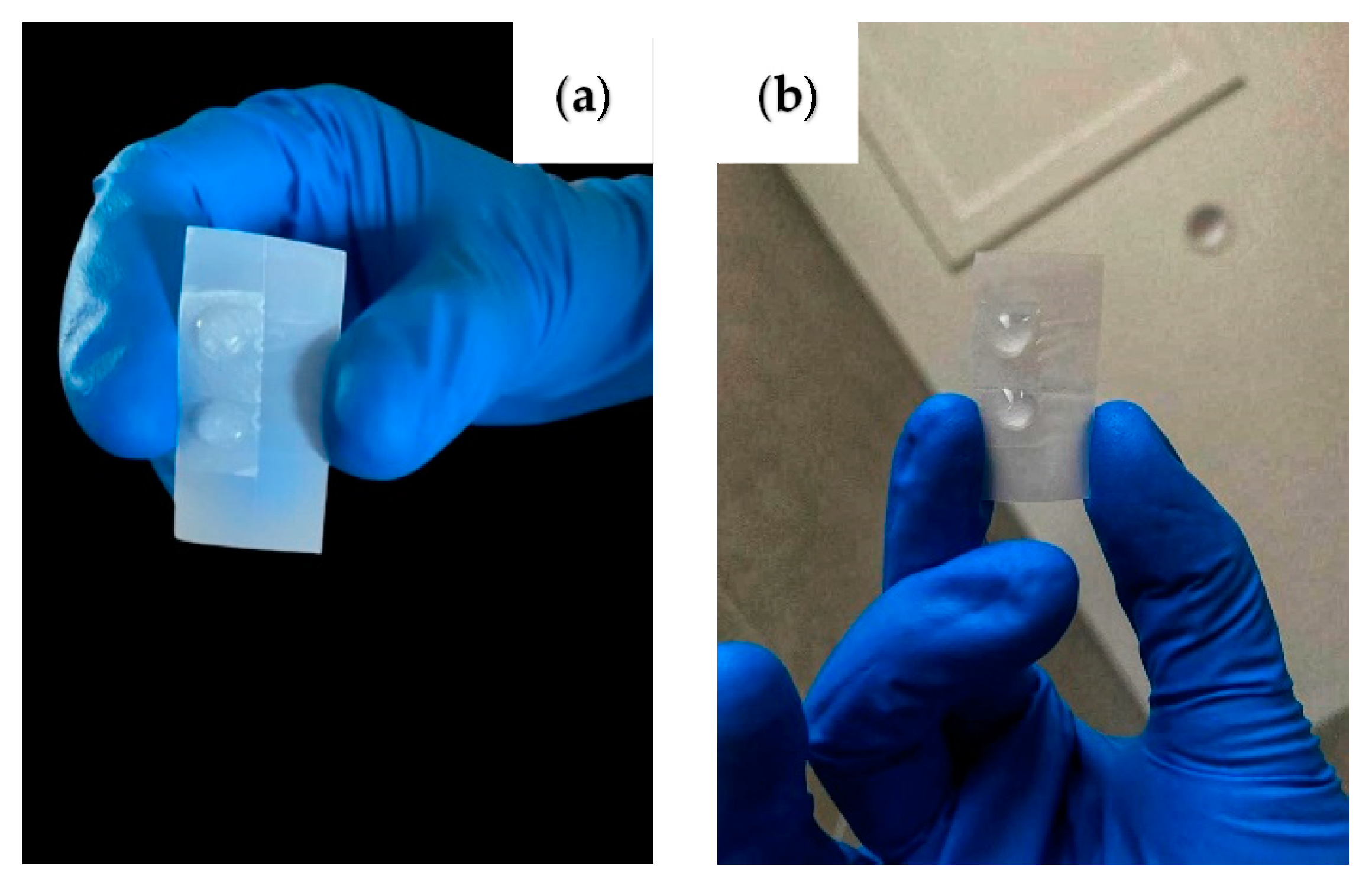Biomimetic Rose Petal Structures Obtained Using UV-Nanoimprint Lithography
Abstract
:1. Introduction
2. Materials and Methods
2.1. Materials
2.2. Inverse Rose Petal Structures
2.3. Rose Petal Structures
2.4. Characterization
3. Results and Discussion
4. Conclusions
Author Contributions
Funding
Conflicts of Interest
References
- Fu, Y.X.; Soldera, M.; Wang, W.; Milles, S.; Deng, K.F.; Voisiat, B.; Nielsch, K.; Lasagni, A.F. Wettability control of polymeric microstructures replicated from laser-patterned stamps. Sci. Rep. 2020, 10, 22428. [Google Scholar] [CrossRef] [PubMed]
- Xia, F.; Jiang, L. Bio-inspired, smart, multiscale interfacial materials. Adv. Mater. 2008, 20, 2842–2858. [Google Scholar] [CrossRef]
- Yao, X.; Song, Y.L.; Jiang, L. Applications of Bio-Inspired Special Wettable Surfaces. Adv. Mater. 2011, 23, 719–734. [Google Scholar] [CrossRef] [PubMed]
- Baji, A.; Abtahi, M.; Ramakrishna, S. Bio-Inspired Electrospun Micro/Nanofibers with Special Wettability. J. Nanosci. Nanotechnol. 2014, 14, 4781–4798. [Google Scholar] [CrossRef]
- Raut, H.K.; Ranganath, A.S.; Baji, A.; Wood, K.L. Bio-inspired hierarchical topography for texture driven fog harvesting. Appl. Surf. Sci. 2019, 465, 362–368. [Google Scholar] [CrossRef]
- Barthlott, W.; Neinhuis, C. Purity of the sacred lotus, or escape from contamination in biological surfaces. Planta 1997, 202, 1–8. [Google Scholar] [CrossRef]
- Patankar, N.A. Mimicking the lotus effect: Influence of double roughness structures and slender pillars. Langmuir 2004, 20, 8209–8213. [Google Scholar] [CrossRef]
- Chen, L.W.; Guo, Z.G.; Liu, W.M. Biomimetic Multi-Functional Superamphiphobic FOTS-TiO2 Particles beyond Lotus Leaf. ACS Appl. Mater. Interfaces 2016, 8, 27188–27198. [Google Scholar] [CrossRef]
- Wang, P.W.; Zhao, T.Y.; Bian, R.X.; Wang, G.Y.; Liu, H. Robust Superhydrophobic Carbon Nanotube Film with Lotus Leaf Mimetic Multiscale Hierarchical Structures. ACS Nano 2017, 11, 12385–12391. [Google Scholar] [CrossRef]
- Dou, X.Q.; Zhang, D.; Feng, C.L.; Jiang, L. Bioinspired Hierarchical Surface Structures with Tunable Wettability for Regulating Bacteria Adhesion. ACS Nano 2015, 9, 10664–10672. [Google Scholar] [CrossRef]
- Liu, Y.; Li, X.L.; Jin, J.F.; Liu, J.A.; Yan, Y.Y.; Han, Z.W.; Ren, L.Q. Anti-icing property of bio-inspired micro-structure superhydrophobic surfaces and heat transfer model. Appl. Surf. Sci. 2017, 400, 498–505. [Google Scholar] [CrossRef]
- Wang, J.M.; Yang, Q.L.; Wang, M.C.; Wang, C.; Jiang, L. Rose petals with a novel and steady air bubble pinning effect in aqueous media. Soft Matter 2012, 8, 2261–2266. [Google Scholar] [CrossRef]
- Zhu, M.F.; Zuo, W.W.; Yu, H.; Yang, W.; Chen, Y.M. Superhydrophobic surface directly created by electrospinning based on hydrophilic material. J. Mater. Sci. 2006, 41, 3793–3797. [Google Scholar] [CrossRef]
- Dai, S.X.; Zhang, D.B.; Shi, Q.; Han, X.; Wang, S.J.; Du, Z.L. Biomimetic fabrication and tunable wetting properties of three-dimensional hierarchical ZnO structures by combining soft lithography templated with lotus leaf and hydrothermal treatments. Crystengcomm 2013, 15, 5417–5424. [Google Scholar] [CrossRef]
- Kuo, W.K.; Hsu, J.J.; Nien, C.K.; Yu, H.H. Moth-Eye-Inspired Biophotonic Surfaces with Antireflective and Hydrophobic Characteristics. ACS Appl. Mater. Interfaces 2016, 8, 32021–32030. [Google Scholar] [CrossRef]
- Wang, D.P.; Zhao, A.W.; Li, L.; He, Q.Y.; Guo, H.Y.; Sun, H.G.; Gao, Q. Bioinspired ribbed hair arrays with robust superhydrophobicity fabricated by micro/nanosphere lithography and plasma etching. Rsc Adv. 2015, 5, 96404–96411. [Google Scholar] [CrossRef]
- Yao, M.; Zhang, P.P.; Nie, J.; He, Y. The Superhydrophobic Fluorine-Containing Material Prepared Through Biomimetic UV Lithography for Oil-Water Separation and Anti-Bioadhesion. Macromol. Chem. Phys. 2021, 222, 2100149. [Google Scholar] [CrossRef]
- Wen, G.; Guo, Z.G.; Liu, W.M. Biomimetic polymeric superhydrophobic surfaces and nanostructures: From fabrication to applications. Nanoscale 2017, 9, 3338–3366. [Google Scholar] [CrossRef]
- Ellinas, K.; Tserepi, A.; Gogolides, E. Durable superhydrophobic and superamphiphobic polymeric surfaces and their applications: A review. Adv. Colloid Interface Sci. 2017, 250, 132–157. [Google Scholar] [CrossRef]
- Bing, W.; Wang, H.; Tian, L.M.; Zhao, J.; Jin, H.C.; Du, W.B.; Ren, L.Q. Small Structure, Large Effect: Functional Surfaces Inspired by Salvinia Leaves. Small Struct. 2021, 2, 2100079. [Google Scholar] [CrossRef]
- Chi, J.J.; Zhang, X.X.; Wang, Y.T.; Shao, C.M.; Shang, L.R.; Zhao, Y.J. Bio-inspired wettability patterns for biomedical applications. Mater. Horiz. 2021, 8, 124–144. [Google Scholar] [CrossRef]
- Nagappan, S.; Park, S.S.; Ha, C.S. Recent Advances in Superhydrophobic Nanomaterials and Nanoscale Systems. J. Nanosci. Nanotechnol. 2014, 14, 1441–1462. [Google Scholar] [CrossRef]
- Papageorgiou, D.P.; Tsougeni, K.; Tserepi, A.; Gogolides, E. Superhydrophobic, hierarchical, plasma-nanotexture polymeric microchannels sustaining high-pressure flows. Microfluid. Nanofluidics 2013, 14, 247–255. [Google Scholar] [CrossRef]
- Dimitrakellis, P.; Gogolides, E. Hydrophobic and superhydrophobic surfaces fabricated using atmospheric pressure cold plasma technology: A review. Adv. Colloid Interface Sci. 2018, 254, 1–21. [Google Scholar] [CrossRef]
- Lazo, M.A.G.; Katrantzis, I.; Vacche, S.D.; Karasu, F.; Leterrier, Y. A Facile in Situ and UV Printing Process for Bioinspired Self-Cleaning Surfaces. Materials 2016, 9, 738. [Google Scholar] [CrossRef]
- Li, Y.Y.; John, J.; Kolewe, K.W.; Schiffman, J.D.; Carter, K.R. Scaling Up Nature: Large Area Flexible Biomimetic Surfaces. Acs Appl. Mater. Interfaces 2015, 7, 23439–23444. [Google Scholar] [CrossRef]
- Xie, H.; Huang, H.X.; Peng, Y.J. Rapid fabrication of bio-inspired nanostructure with hydrophobicity and antireflectivity on polystyrene surface replicating from cicada wings. Nanoscale 2017, 9, 11951–11958. [Google Scholar] [CrossRef]
- Choo, S.; Choi, H.J.; Lee, H. Replication of rose-petal surface structure using UV-nanoimprint lithography. Mater. Lett. 2014, 121, 170–173. [Google Scholar] [CrossRef]
- Darmanin, T.; Bombera, R.; Colpo, P.; Valsesia, A.; Laugier, J.P.; Rossi, F.; Guittard, F. Bioinspired Rose-Petal-Like Substrates Generated by Electropolymerization on Micropatterned Gold Substrates. Chempluschem 2017, 82, 352–357. [Google Scholar] [CrossRef] [PubMed]
- Oncel, M.O.O.; Erkoc-Biradli, F.Z.; Rasier, R.; Marcali, M.; Elbuken, C.; Garipcan, B. Rose petal topography mimicked poly (dimethylsiloxane) substrates for enhanced corneal endothelial cell behavior. Mater. Sci. Eng. C-Mater. Biol. Appl. 2021, 126, 112147. [Google Scholar] [CrossRef] [PubMed]
- Yang, H.S.; Lee, B.; Tsui, J.H.; Macadangdang, J.; Jang, S.Y.; Im, S.G.; Kim, D.H. Electroconductive Nanopatterned Substrates for Enhanced Myogenic Differentiation and Maturation. Adv. Healthc. Mater. 2016, 5, 137–145. [Google Scholar] [CrossRef]
- Ems, H.; Ndao, S. Microstructure-alone induced transition from hydrophilic to hydrophobic wetting state on silicon. Appl. Surf. Sci. 2015, 339, 137–143. [Google Scholar] [CrossRef]
- Hou, T.F.; Shanmugasundaram, A.; Nguyen, B.Q.H.; Lee, D.W. Fabrication of surface functionalized PUA composites to achieve superhydrophobicity. Micro Nano Syst. Lett. 2019, 7, 12. [Google Scholar] [CrossRef]
- Wang, J.D.; Liu, F.B.; Chen, H.S.; Chen, D.R. Superhydrophobic behavior achieved from hydrophilic surfaces. Appl. Phys. Lett. 2009, 95, 084104. [Google Scholar] [CrossRef]




Publisher’s Note: MDPI stays neutral with regard to jurisdictional claims in published maps and institutional affiliations. |
© 2022 by the authors. Licensee MDPI, Basel, Switzerland. This article is an open access article distributed under the terms and conditions of the Creative Commons Attribution (CC BY) license (https://creativecommons.org/licenses/by/4.0/).
Share and Cite
Oopath, S.V.; Baji, A.; Abtahi, M. Biomimetic Rose Petal Structures Obtained Using UV-Nanoimprint Lithography. Polymers 2022, 14, 3303. https://doi.org/10.3390/polym14163303
Oopath SV, Baji A, Abtahi M. Biomimetic Rose Petal Structures Obtained Using UV-Nanoimprint Lithography. Polymers. 2022; 14(16):3303. https://doi.org/10.3390/polym14163303
Chicago/Turabian StyleOopath, Sruthi Venugopal, Avinash Baji, and Mojtaba Abtahi. 2022. "Biomimetic Rose Petal Structures Obtained Using UV-Nanoimprint Lithography" Polymers 14, no. 16: 3303. https://doi.org/10.3390/polym14163303
APA StyleOopath, S. V., Baji, A., & Abtahi, M. (2022). Biomimetic Rose Petal Structures Obtained Using UV-Nanoimprint Lithography. Polymers, 14(16), 3303. https://doi.org/10.3390/polym14163303






